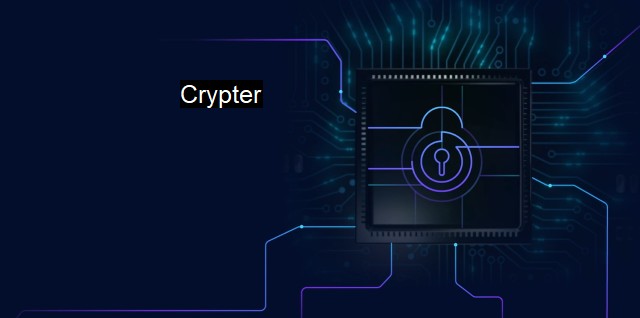What is Crypter?
Crypters: The Cyber Threat Evading Detection by Antivirus Tools
Crypter, with refers to a software tool that can transform or encrypt a file to disguise its content, including its signatures, from both users and automated security solutions such as antivirus software.Cybercriminals and individuals involved in nefarious online acts often use this tool to avoid detection of their maliciously intended software, commonly known as malware. The alternate forms generated by Crypter avoid the predefined security rules, thus escape retinal scanning by antivirus software and are able to instigate the cyber attack. This makes Crypter an essential tool for cybercriminals and hackers who largely rely on this technique to prevent antivirus software from pushing them out of work and foiling the destructuring algorithms.
Crypters serve as a form of shield against any antivirus software. Most malware like Trojans, backdoors, and ransomware will take refuge under a Crypter’s shroud to hide from an antivirus detection engine. The authenticity of the source code from the original malware file remains intact. The Crypter's only job is to make required amendments around the core code so the detection mechanisms of antivirus software treat it as a legitimate file. Once these manipulated files gain entry into the system, they act like ticking time bombs waiting to explode.
Crypter usage spreads far beyond identity theft, as it can be sued to assist in stealing data, conducting espionage, causing damage to systems, or distributing misinformation. Given the right circumstances, Crypters could be utilized to instigate wide-scale digital disruption. Due to these reasons, it is not uncommon to see updated versions of Crypters being sold in the vast underbelly of the cyber black market.
Not all Crypters are created equal. There are plenty of factors that determine the potency of a Crypter, including the quality of its source code, execution method, and ability to evade detection from antivirus software. There are two main types of Crypters: Runtime Crypters and Scantime Crypters.
Runtime Crypters allow malware to stealthily carry out operations during the execution process while making them invisible to security mechanisms. On the other hand, Scantime Crypters ward off antivirus scans without executing the malware's payload, making it seemingly harmless until it is actively run.
As the cybersecurity world continues to evolve, antivirus software has become increasingly more sophisticated to deal with Crypter-related threats. These include essential features such as heuristic analysis and sandbox environments. Heuristic analysis is a proactive, advanced approach that seeks out newly crafted malware by examining its structure and behavior. This nullifies the Crypter's logic of shape-shifting and eventually helps antivirus software detect hidden malicious files. Meanwhile, sandbox environments allow the suspicious files to execute in a closed-off space, assessing its behavior and origins without risking harm to the host computer.
Decrypting a Crypter is typically done by deducing the encryption key. Most Crypters use symmetric encryption, meaning that the same key is used for both the encryption and decryption processes. By capturing this piece of information, security experts can reverse-engineer the process and potentially unveil the inner workings of the malware.
Crypter proves to be a dangerous tool in the hands of cybercriminals and plays a significant role in the cybersecurity scene. Regardless, advancement in antivirus technologies, coupled with proper cyber hygiene and vigilance from users, is continuously restraining this tool from causing large-scale havoc.
Crypters may offer cyber threats a chance to elude initial detection, but they cannot provide immunity. Persistent effort in strengthening cybersecurity infrastructure and ensuring the consistent update of antivirus software will empower individuals and organizations to stay one step ahead of the hackers. The world of cybersecurity remains complex and challenging, and massive outbreaks of malicious crypters are a stark reminder of the perpetual fight between hackers and those striving to maintain digital safety.

Crypter FAQs
What is a crypter in the context of cybersecurity?
A crypter is a type of software that is designed to encrypt malware and other harmful software so that it can bypass antivirus detection.How does a crypter work?
A crypter works by encrypting the malware payload with a unique encryption key. This makes it harder for antivirus software to detect the malware since it appears as a jumbled mess of code instead of a recognizable virus signature.Are crypters illegal?
No, crypters themselves are not illegal. However, using a crypter to distribute malware or other malicious software is illegal and can result in severe legal consequences.How can I protect my computer from crypter malware?
To protect your computer from crypter malware, you should install a reputable antivirus program and keep it up to date. You should also avoid downloading suspicious files or opening email attachments from unknown senders. Additionally, maintaining good cybersecurity habits such as using strong passwords and avoiding public Wi-Fi networks can also help protect your computer from malware.| | A | | | B | | | C | | | D | | | E | | | F | | | G | | | H | | | I | | | J | | | K | | | L | | | M | |
| | N | | | O | | | P | | | Q | | | R | | | S | | | T | | | U | | | V | | | W | | | X | | | Y | | | Z | |
| | 1 | | | 2 | | | 3 | | | 4 | | | 7 | | | 8 | | |||||||